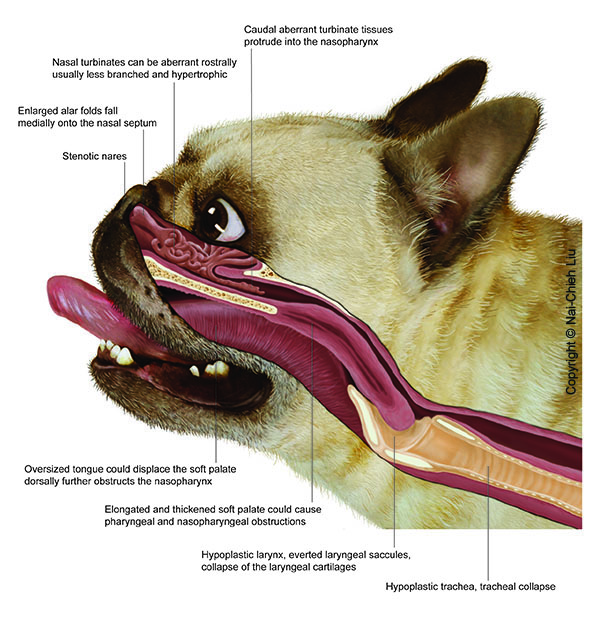Pathophysiology of BOAS
Anatomical Components
Shortening of the skull and upper airway tract lesions
In brachycephalic dogs, while the length of the skeletal muzzle is reduced, there is often no corresponding decrease in the size of the soft tissue contained in the skull. This results in a constricted effect within the nasal cavity and partial obstruction of the pharynx and larynx.

All images are copyright of the University of Cambridge or individual contributors, all rights reserved, no reproduction without permission.
Pathophysiology
Upper airway tract obstruction & poor thermoregulation
Excessive selection for brachycephaly has deformed the upper airway tract and resulted in obstructions. Affected brachycephalic dogs must increase their inspiratory effort to overcome the resistance generated by the upper airway obstruction and thus achieve sufficient ventilation.
This increased inspiratory effort generates a high negative pressure that sucks the soft tissues into the lumen of the airway passage. Eventually, these tissues become hyperplastic and the laryngeal cartilages collapse, further exacerbating the airway obstruction. If this cycle is left uninterrupted, the dog may develop pulmonary oedema, reduced arterial oxygen content, hypertension and right-sided heart failure.
In addition to the respiratory function, BOAS also affects the crucial thermoregulatory role of the canine airway. This is evident in the severe heat susceptibility seen in affected brachycephalic dogs. Dogs do not sweat. Instead, they lower their body temperature by panting. When dogs with elongated skull shapes (like Labradors) pant, they are able to pass air quickly over the throat and nose. The dog cools down as saliva and moisture evaporate when air passes over the tongue and mucous membranes in the oral and nasal cavities. However, in the obstructed brachycephalic dog, the airway tract becomes inflamed and swollen during the panting process. This results in greater obstruction and further over-heating.
Another factor contributing to airway obstruction is obesity. Excessive weight results in fat tissue surrounding and narrowing the airway. Therefore, a weight loss program should be implemented to improve respiratory function in overweight brachycephalic dogs.
